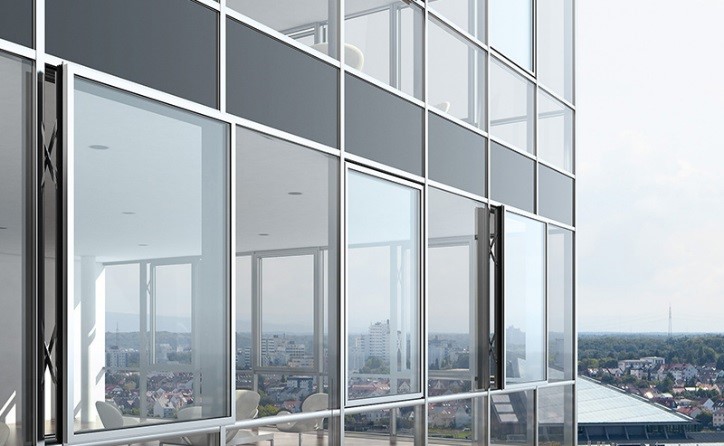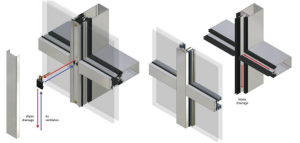Curtain wall façade (lamel)
Glass curtain wall system is an outer covering of a building in which the outer walls are non-structural, but merely keep the weather out and the occupants in. As the curtain wall is non-structural it can be made of a lightweight material, reducing construction costs. When glass is used as the curtain wall, a great advantage is that natural light can penetrate deeper within the building. The curtain wall façade does not carry any dead load weight from the building other than its own dead load weight. The wall transfers horizontal wind loads that are incident upon it to the main building structure through connections at floors or columns of the building. A curtain wall is designed to resist air and water infiltration, sway induced by wind and seismic forces acting on the building, and its own dead load weight forces.

Key visual features of curtain walls are glazing appearance (see Glazing) and sightlines. Sightlines are defined as the visual profile of the vertical and horizontal mullions. The sightlines are a function of both the width and depth of the curtain wall frame. Lateral load resistance requirements (wind loads, spans) generally dictate frame depth. Where narrow sightlines are desired, steel stiffeners inserted into the hollow frame of aluminum extrusions can help reduce frame depth.

The acoustic performance of curtain walls is primarily a function of the glazing and internal seals to stop air leakage (covered elsewhere). The sound attenuation capability of curtain walls can be improved by installing sound attenuating infill and by making construction as airtight as possible. Incorporating different thicknesses of glass in an insulated glass unit will also help to mitigate exterior noise. This can be accomplished by increasing the thickness of one of the lites of glass or by incorporating a laminated layer of glass with a noise-reducing interlayer, typically a polyvinyl butyral or PVB.
Curtain Wall Advantages
- Excellent structural integrity
- Resistant to moisture, wind, heat and earthquakes
- Little maintenance
- Design according to customers’ requirements
- Manufacture under complete quality control system---ISO9001
- Fast construction and easy installation.
- Installation with instruction of experienced engineers
- Hight quality and low-price
Types of Curtain Wall Systems
 Ladder systems
Ladder systems- Unitized systems
- Rainscreen principle
- Stick systems
